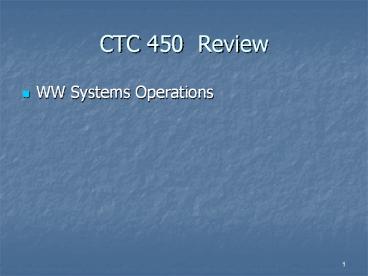CTC 450 Review - PowerPoint PPT Presentation
1 / 16
Title:
CTC 450 Review
Description:
CTC 450 Review WW Systems Operations Objectives Understand the basics with respect to advanced WW treatment Two systems Primary, Secondary, Sludge Advanced (tertiary ... – PowerPoint PPT presentation
Number of Views:79
Avg rating:3.0/5.0
Title: CTC 450 Review
1
CTC 450 Review
- WW Systems Operations
2
Objectives
- Understand the basics with respect to advanced WW
treatment
3
Two systems
- Primary, Secondary, Sludge
- Advanced (tertiary and ww reclamation)
- Remove phosphorous
- Convert ammonia to nitrate (nitrification)
- Convert nitrate to nitrogen (denitrification)
- Inactivate pathogens
- Remove heavy metals
- Remove organic chemicals
- Remove inorganic salts
- Eliminate all pathogens
4
Limitations-Biological Treatment
- Doesnt remove phosphorous or ammonia
- Incomplete disinfection
- Doesnt remove all toxins
- Doesnt remove nonbiodegradable soluble chemicals
5
Pathogens
- Conventional biological treatment
- Up to 99.9 removal
- With disinfection up to 99.99
- Protozoal cysts and helminth eggs are resistant
6
SS Removal-Advanced
- Granular-Media filters (similar to water
treatment) - Cloth Media filters
- Membrane filters
7
Pathogen Removal-Advanced
- Remove solids first via filtration (pathogens can
be protected in the solids) - Chlorination (similar to water treatment)
8
Toxic Substance Removal
- Toxic-Hazardous to aquatic life or human health
- Priority toxic water pollutants-over 100
- Evaluating toxicity
- Test influent/effluent for specific substances
- Biomonitor-fathead minnows, water flea
9
Phosphorous Removal
- Soluble or organic (organically bound)
- Conventional treatment removes 20-40 of
phosphorus - Example 1.3
- Advanced treatments
- Chemical-biological
- Reverse osmosis
10
Chemical-Biological
- Chemical precipitation using aluminum or iron
coagulants - Added to primary clarifier, before biological
process, or to final clarifier - Biological removal (conventional)
11
Nitrogen
- Organic
- Decomposes to ammonia
- Ammonia
- Nitrosomonas oxidize ammonia to nitrite
- Nitrite
- Nitrobacter oxidize nitrite to nitrate
- Nitrate
- Under anaerobic conditions via facultative
heterotrophs, nitrates are converted to nitrogen
gas (which escapes into the atmosphere) - Nitrogen gas
12
Nitrogen in WW
- 40 ammonia 60 is bound in organic matter
- Not enough oxygen to convert to nitrites or
nitrates
13
Nitrogen Removal-Conventional
- Primary sedimentation (15 removal)
- Biological treatment (another 10)
- Remainder is mainly in the form of ammonia unless
oxidation occurs (activated sludge at low BOD
loading)
14
Nitrogen Removal-Advanced
- After biological treatment
- Aeration
- Final settling
- Alkalinity is reduced when nitrification takes
place lime or soda ash is added to maintain
alkalinity
15
Nitrate removal
- Nitrate can pollute groundwater
- Denitrification converts nitrates to nitrogen gas
- Process is anaerobic or anoxic
- Process requires an organic carbon source
(methanol or raw ww) - Via recycle, denitrification can be placed ahead
of nitrification
16
EBPR-Enhanced Biological Phosphorous Removal
- Anoxic zone (0.5 to 3 hours detention time)
followed by aerobic zone (6-24 hrs)































